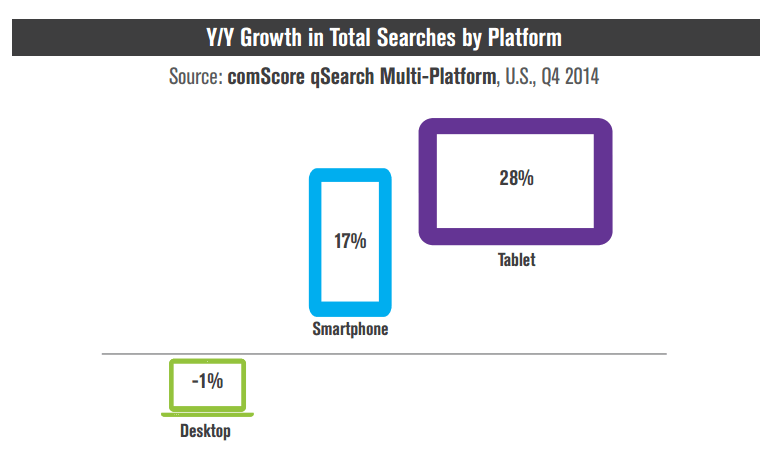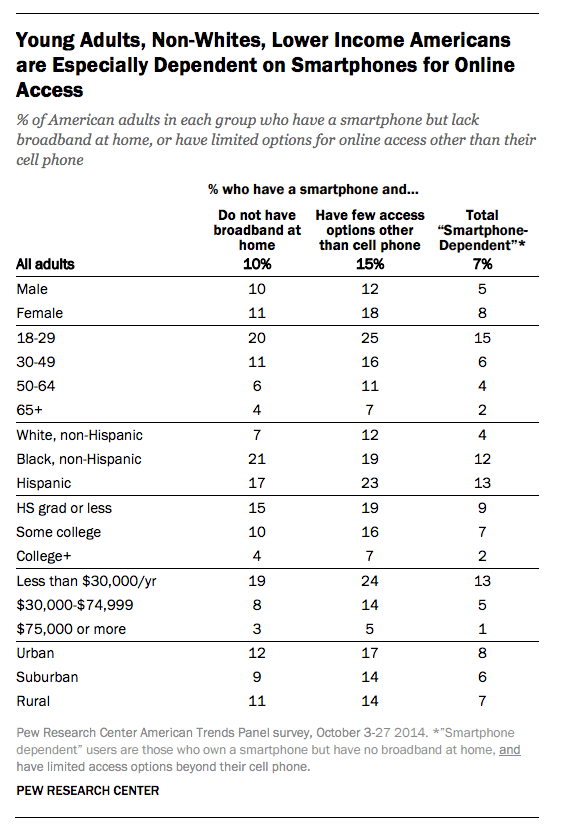Mobile has grown significantly in recent years, with Google now saying that mobile search has surpassed desktop search. But columnist Kristine Schachinger questions the wisdom of blindly adopting a “mobile first” mindset.
The recent news that mobile searches have surpassed desktop searches on Google was considered monumental.
There is no arguing that mobile is not tremendously important. Even for those who did not previously think much about mobile, there was no way to miss Google’s announced “Mobilegeddon” — it was the SEO’s Y2K. Any business in today’s market that ignores its mobile presence does so at their own peril.
This emphasis on mobile might be a story of its own making, however. To be sure, mobile has come a long way since just a few years ago. Yet this new focus on “everything mobile” and “mobile first” might be misplaced if it is to the exclusion of your multi-device users.
What if “mobile first” is not everything it’s hyped to be? What if you are sacrificing real users and real money on the altar of “mobileness”?
Proximity Is Everything
Just as in the golden days of brick-and-mortar stores, location is everything. Your proximity to the customer makes a huge difference — and this is just as true online as it is off.
Brands’ opportunities to be “near” mobile users are increasing as people are becoming more and more tethered to their mobile devices. In a recent Pew Research report, 46% of respondents said they could not live without their smartphone; earlier research had 44% of respondents reporting that they sleep with their phones. The only way a brick-and-mortar store could hope to have that much time with a potential customer is if they put beds in their attics and created a room from which to work!
In light of that, the increase in mobile usage really does not come as a surprise. Your desktop does not make a very comfy pillow — and having a smartphone nearby all day every day is giving mobile users access that is, in fact, game-changing.
However, before you decide to follow the mobile-first path, have you thought how much it actually matters to your business? What are we missing when we just look at numbers of users and searchers? Are all these searches as important as we think? If we are not careful and critical in our evaluations, we might be missing a lot.
Is Mobile Truly Dominating?
Everyone needs to have a mobile-friendly site, lest they miss out on potentially important users and site traffic. However, we should be careful of focusing on mobile at the expense of desktop-only or multi-device users.
The perception that mobile is crushing desktop is just that — a perception. In reality, that is not exactly the case. Most people today are multi-device oriented. Rather than mobile taking a larger share of the pie, the pie is simply getting bigger.

Total Digital Media Time Spent by Platform, Dec 2010 vs. Dec. 2014. From comScore’s “2015 U.S. Digital Future in Focus” whitepaper.
A recent comScore report, “2015 U.S. Digital Future in Focus,” explains:
[blockquote]While most of the growth in digital media consumption over the past four years has occurred on smartphones (up 394 percent) and tablets (up 1,721 percent), these mobile platforms are not eating into aggregate time spent on desktop, which has still grown 37 percent over this time period. The digital media pie continues to get bigger and Americans engage with screens during more occasions throughout the day than ever before.[/blockquote]
Over the past four years, usage on all device types has grown, desktop included. So mobile has not grown not at the expense of desktop, but rather in addition to it. The increase in mobile use can more likely be attributed to a combination of greater proximity/access and specific user intents than to the death of desktop search (as is so often presumed).
Looking at mobile search in particular paints a similar picture. According to the comScore report, mobile search activity experienced significant growth from Q4 2013 to Q4 2014, but desktop search only declined 1% year-over-year. This suggests that the growth in mobile search did not come at the expense of desktop search, but rather was due to overall search market growth.

Year-over-year search growth, by device. From comScore’s “2015 U.S. Digital Future in Focus” whitepaper.
As you can see, desktop is not losing ground — and that very slight decrease of 1% is much more likely correlated to mobile proximity than to a switch from desktop to mobile. (i.e., You have a question you cannot answer, and your mobile device is handy — so you just pull up Google and go.) The growth in mobile search traffic seems to be correlated to device proximity than a real change in how we search.
In light of mobile searches surpassing desktop searches, it would be easy to assume a user preference for mobile over desktop. However, mobile use (including mobile search) is highly vertical dependent. The dominance of mobile is limited to a few specific categories; in fact, there are still several areas where desktop dominates.

Time spent on mobile vs. desktop per content category (tablets included in mobile). From comScore’s “2015 U.S. Digital Future in Focus” whitepaper.
Even in the verticals where mobile dominates (such as social networking), many of those mobile users are also desktop users. Taking a closer look at some of the top websites in the U.S., we see that there is a large contingent of users accessing these sites from multiple devices — the “mobile only” crowd is actually a minority in many cases.

Unique visitors (by device) to top digital media properties. From comScore’s “2015 U.S. Digital Future in Focus” whitepaper.
If we miss this fact, we may concentrate our design and marketing efforts too heavily on mobile, at the expense of our desktop and multi-platform users. This could be problematic if your vertical is not a “mobile first” niche.
Conflicting Data On Search
To make matters more complicated, looking at different data can lead to different conclusions about mobile’s dominance in search.
In contrast to Google’s claim in May 2015 that “more Google searches take place on mobile devices than on computers in 10 countries including the US and Japan,” the above-referenced comScore report puts mobile searches at only 29% of total U.S. searches as of Q4 2014.
[blockquote]Mobile search, which includes queries conducted via app and mobile browser, now accounts for 29 percent of all search activity, with smartphones driving a greater share (20 percent) than tablets (9 percent).[/blockquote]
Why the discrepancy? There could be several explanations. First and foremost, we’re looking at different data sets — Google’s numbers only take into account Google search data, whereas comScore includes data from other search engines, as well as in-app searches. It’s also possible that exponential growth in mobile searches has occurred between when the comScore data was recorded (Q4 2014) and when Google’s data was recorded (unknown, but presumably sometime in Q1 2015).
Granted, mobile search will likely continue to grow, especially as more and more people become smartphone owners. However, this new focus on mobile search appears to often be interpreted as “mobile is good, desktop is done,” and this is not supported by the data.
If we are not aware of how people are really using their devices — and accessing our web properties — then mobile-first thinking can create a self-fulfilling prophecy that hurts our desktop or multi-platform performance by improperly focusing our time and resources on just one aspect of our web presence.
Mobile Usage: A Deeper Dive
Given all this data, the question now becomes, “How — and by whom — is mobile being used in a multi-device world?” Let’s take a closer look.
Micro-Moments In Mobile Search
Google has extensively studied mobile search and app use and has coined a new term: “micro-moments.” These micro-moments are defined as “the I want-to-know moments, I want-to-go moments, I want-to-do moments, and I want-to-buy moments” that drive search behavior.
[blockquote]Micro-moments occur when people reflexively turn to a device — increasingly a smartphone — to act on a need to learn something, do something, discover something, watch something, or buy something. They are intent-rich moments when decisions are made and preferences shaped.[/blockquote]
In other words, these micro-moments encompass the little pieces of informational content people search for during the course of their day-to-day lives, often beginning with a mobile search query. Such queries often take the form of a question — for example:
- Who was the 32nd president of the United States?
- What are that restaurant’s reviews?
- When does the movie start?
- Where can I get the best sushi in town?
- Why is the sky blue?
- How do I make brownies?
In fact, Google highlights these micro-moments in a recent ad for their Google app, in which they show how “A question can take you anywhere.”

From Google’s point of view, “questions” are life changing. They lead to adventures and enlightenment. That’s the power of mobile search!
Well, not so fast. For most of us, mobile search is more about supporting daily user activities than it is about blazing new pathways in life. Furthermore, mobile search is only a small percentage
The Demographics Of Mobile Users vs. Desktop Users
According to Pew Research, certain groups are more likely than others to depend on smartphones as their only or primary means of online access. These groups include younger adults, those with low household incomes, and non-whites.
[blockquote]The survey measured this reliance on smartphones for online access in two different ways — first, by asking smartphone owners whether or not they have traditional broadband service at home, and second, whether they have a reasonable number of options for accessing the internet in general — and found that:
- 10% of Americans own a smartphone but do not have any other form of high-speed internet access at home beyond their phone’s data plan.
- Using a broader measure of the access options available to them, 15% of Americans own a smartphone but say that they have a limited number of options for going online other than their cell phone.
In all, 19% of Americans fall into one or the other of these categories, and 7% of the public indicates that both conditions apply to them — that is, they own a smartphone but lack any other type of high-speed access at home, and have limited options for going online other than their cell phone. Throughout this report, we will refer to this 7% of Americans as “smartphone-dependent” users.[/blockquote]

We can thus conclude that Desktop or Desktop+Mobile users tend to be those who are:
- Between the ages of 30-55+
- College Educated
- Make over 30,000 a year
- Live in Suburbia (though the differences here are small)
Desktop primary and desktop+mobile users have more money and education than your “mobile only” or “mobile primary” users. Furthermore, Pew’s recent analysis of comScore traffic data found that “desktop visitors spent at least 10% more time per visit than did those coming to the site or app on their mobile device” for half of the top 50 digital news outlets, suggesting that desktop users are stickier and more engaged.
These are very important traits to know about your audience when creating a marketing campaign, but especially if you are primarily focusing on a mobile effort.
E-Commerce On Mobile & Desktop
What if we take this a step further and look at buy paths, not just search? Certainly, people are utilizing their mobile devices to purchase, right? Well, they are — but not at the levels that recent headlines would seem to indicate.
While e-commerce searches and time spent online around e-commerce decisions have increased dramatically, the same is not really true for dollars spent on mobile devices. There is a low correlation between time spent and dollars spent via mobile. So what are users doing with respect to mobile and e-commerce?
Showrooming is the practice of comparison-shopping to get the best price. Typically a user would go into the store and find the item to see what it looked like live and in person, to then go online and see who is offering it for less. However, once thought to be the way of the future, this process is not as popular as the now more common “reverse showrooming.” In the U.S., 69% of people have reverse showroomed, while only 46% have showroomed, according to a Harris poll.
When users go online to research and compare items, but then go into a brick-and-mortar store to purchase the item, this is known as “reverse showrooming” or “webrooming.” The popularity of this technique, though organic in nature, is not growing by accident and happenstance. Brick-and-mortar stores noting the trend have tapped into those channels to better market their products with the idea that their store is an end destination in the buying process.
Whether showrooming or webrooming, users still prefer to purchase on desktop instead of mobile. Even the uber mobile savvy Millenials are going to desktop at rates 20% to 30% greater than mobile when they want to make a purchase, according to a recent eMarketer article summarizing data on the subject, which goes on to say:
[blockquote]Plenty of millennials have used their smartphone to transact a purchase, but this has not become standard practice for a majority. In a September 2014 Annalect survey of US smartphone users ages 19 to 33, 40% said they use their smartphones “to make an actual purchase,” vs. 65% doing so via computer.[/blockquote]

While mobile is a significant part of the purchase path, it is not where people — even digital natives — are primarily spending their money.
Will mobile purchases increase over time? Sure. There is little reason to think that there will not be significant growth in mobile purchasing as websites and apps become more e-commerce friendly. However, the restrictive nature of mobile screen sizes (which limits the ability to see what you are purchasing) is not likely to change anytime soon.
As long as this is true, there will be a natural limit to how large that mobile e-commerce pie will grow. For items that don’t require a “looksee,” it is likely to be a much stronger growth curve than for items that do (like clothing).
When To Question The Mobile-First Mentality: A Hypothetical Example
By now, it should be clear how important it is for marketers to understand mobile search trends combined with demographic information.
Let’s say you’re marketing high-end leisure travel to members of the AARP. You might notice that one of the largest mobile search verticals is travel. Great! Let’s go mobile!
But wait — older people don’t use mobile as heavily and younger generations, and that is our target audience, right? Okay! Let’s target desktop users — after all, they fit our demographic (older, money, etc.). However, as we look further into the data, we find that the largest-growing group of potential customers on mobile are over 55. Okay, let’s go “mobile first” after all!
Well, except we know that desktop users are more likely to make a purchase than mobile users, especially those who are older and… around and around the circle goes.
As you can see, breaking it down by search vertical, device type and demographics shows that our choice should not be “mobile over desktop” or “desktop over mobile.” Both are equally important — just in very different ways.
But what if you believed that mobile is all that matters in travel? What if you believed the hype and ignored the demographic and trend data surrounding desktop and desktop+mobile users? What if your desktop site was made to look mobile, and this was confusing to traditional desktop users? What if you used only mobile-based ads or mostly mobile-based marketing choices?
If you look at the sheer number of travel searches in mobile, you might think that that is where the majority of your money should be spent. Yet, wouldn’t you miss out on a highly valuable target group if you ignored desktop? Most certainly, yes.
While mobile is vitally important to any online digital effort, knowing how important it is to your company is essential to a proper marketing campaign in 2015 and beyond.
Website Owner, Know Thyself!
The age of mobile has come, along with a lot of hype of how much you need to focus on mobile.
These days, it is about multiple device types and the touch process. It is about understanding how your users’ intent, socioeconomic status, and identity demographics affect their mobile behavior. Not knowing your market intimately can mean you are throwing money away. Research mobile trends. Know your demographics. Understand how multiple devices perform in your buy cycle. Know your users. And make sure you are not going mobile first when you should be going desktop first (but mobile ready) just because everyone else has jumped on the mobile bandwagon.
Be aware. Mobile is great, but mobile is limited. Know how these limitations affect your strategic marketing efforts and bottom line before throwing all your eggs into the “mobile first” basket.




